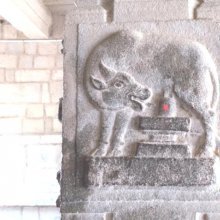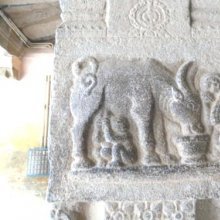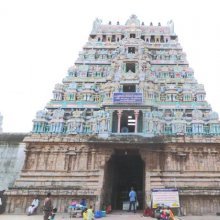Kamadhenu, Kāmadhenu, Kama-dhenu: 24 definitions
Introduction:
Kamadhenu means something in Hinduism, Sanskrit, Jainism, Prakrit, the history of ancient India, Marathi. If you want to know the exact meaning, history, etymology or English translation of this term then check out the descriptions on this page. Add your comment or reference to a book if you want to contribute to this summary article.
Images (photo gallery)
In Hinduism
Vaishnavism (Vaishava dharma)
Source: VedaBase: Śrīmad BhāgavatamThe surabhi cow is also called kāmadhenu. Although Jamadagni possessed only one kāmadhenu, he was able to get from it everything desirable.
Source: Pure Bhakti: Bhagavad-gita (4th edition)Kāmadhenu (कामधेनु) refers to “a cow who can fulfil all desires”. (cf. Glossary page from Śrīmad-Bhagavad-Gītā).

Vaishnava (वैष्णव, vaiṣṇava) or vaishnavism (vaiṣṇavism) represents a tradition of Hinduism worshipping Vishnu as the supreme Lord. Similar to the Shaktism and Shaivism traditions, Vaishnavism also developed as an individual movement, famous for its exposition of the dashavatara (‘ten avatars of Vishnu’).
Shaktism (Shakta philosophy)
Source: Wisdom Library: Śāktism1) Kāmadhenu (कामधेनु, “Wish-Fulfilling Cow”):—One of the names of Mahāsarasvatī (sattva-form of Mahādevī). Kāmadhenu refers to the Devī’s nurturing aspect. Mahālakṣmī is one of the three primary forms of Devī. Not to be confused with Lakṣmī, she is a more powerful cosmic aspect (vyaṣṭi) of Devi and represents the guṇa (universal energy) named sattva. Also see the Devī Māhātmya, a Sanskrit work from the 5th century, incorporated into the Mārkaṇḍeya-Purāṇa.
2) Kāmadhenu (कामधेनु, “Wish-Fulfilling Cow”):—One of the female offspring from Mahākālī (tamas-form of Mahādevī). Mahākālī is one of the three primary forms of Devī, the other two being Mahālakṣmī and Mahāsarasvatī. Not to be confused with Kālī, she is a more powerful cosmic aspect (vyaṣṭi) of Devi and represents the guṇa (universal energy) named tamas. Also see the Devī Māhātmya, a Sanskrit work from the 5th century, incorporated into the Mārkaṇḍeya-Purāṇa.
3) Kāmadhenu (कामधेनु, “the wish-cow”):—One of the names of Sarasvatī, the Hindu goddess of speech, eloquence and all forms of knowledge.
Source: Kamakoti Mandali: The Yoginis of Narasimha VyuhaKāmadhenu (कामधेनु) refers to one of the various Nṛsiṃha Yoginīs or Śaktis created for the purpose of pacifying the Rudraśaktis.—Accordingly, [...] Rudra meditated on Mahānṛsiṃha. Pleased with Rudra’s prayers, Narasiṃha created four Vyūhaśaktis [Vāgīśvarī, Mahāmāyā, Bhagamālinī and Atibhadrakālī=Śuṣkarevatī]. The Lord created a group of Nṛsiṃha Yoginīs [viz., Kāmadhenu] to accompany the three main Śaktis. All of them, under the command of Śuṣkarēvatī, attacked the Rudraśaktis, subdued them and pacified them to attain benevolence.
Source: Brill: Śaivism and the Tantric Traditions (shaktism)Kāmadhenu (कामधेनु) refers to a “wish-fulfilling cow”, according to the King Vatsarāja’s Pūjāstuti called the Kāmasiddhistuti (also Vāmakeśvarīstuti), guiding one through the worship of the Goddess Nityā.—Accordingly, “One who recites this eulogy of Kāmeśvarī called Kāmasiddhi, which serves as a very auspicious wish-fulfilling cow (atimaṅgala-kāmadhenu), placing trust [in her], is specially chosen by [the goddesses of] Beauty, Prosperity, Eloquence, and Treasury of Qualities. So, what would he do with any [other] lovers?”.

Shakta (शाक्त, śākta) or Shaktism (śāktism) represents a tradition of Hinduism where the Goddess (Devi) is revered and worshipped. Shakta literature includes a range of scriptures, including various Agamas and Tantras, although its roots may be traced back to the Vedas.
Purana and Itihasa (epic history)
Source: archive.org: Puranic EncyclopediaKāmadhenu (कामधेनु).—(SURABHI—NANDINĪ). General. She is the first mother of cattle. She is a goddess with marvellous powers and attainments who gives milk whenever needed by gods and sages. The Purāṇas declare that all the cattle in the world today are descended from Kāmadhenu. (See full article at Story of Kāmadhenu from the Puranic encyclopaedia by Vettam Mani)
Source: Cologne Digital Sanskrit Dictionaries: The Purana Index1a) Kāmadhenu (कामधेनु).—A goddess following Revatī;1 gift of.2
1b) Jamadagni's cow providing hospitality to Haihaya hosts; bound by king's servants, she kicked off its shackles and flew in the air.*
- * Brahmāṇḍa-purāṇa III. 26. 54.

The Purana (पुराण, purāṇas) refers to Sanskrit literature preserving ancient India’s vast cultural history, including historical legends, religious ceremonies, various arts and sciences. The eighteen mahapuranas total over 400,000 shlokas (metrical couplets) and date to at least several centuries BCE.
Vyakarana (Sanskrit grammar)
Source: Wikisource: A dictionary of Sanskrit grammarKāmadhenu (कामधेनु).—Abridgment of काव्यकामधेनु (kāvyakāmadhenu) of Bopadeva; the word is also used as a short form for काव्यकामधेनु (kāvyakāmadhenu).

Vyakarana (व्याकरण, vyākaraṇa) refers to Sanskrit grammar and represents one of the six additional sciences (vedanga) to be studied along with the Vedas. Vyakarana concerns itself with the rules of Sanskrit grammar and linguistic analysis in order to establish the correct context of words and sentences.
Pancaratra (worship of Nārāyaṇa)
Source: archive.org: Isvara Samhita Vol 5Kāmadhenu (कामधेनु) or Kāmadhenumudrā or Surabhi is the name of a mudrā described in the Īśvarasaṃhitā 44-46.—Accordingly, “the two hands are to be closely knit and kept facing downwards, the two little fingers and thumbs are to be well pressed together, the pairs of the middle fingers are to be placed each on the back of the opposite palm. The pair of ring fingers and index fingers are to be apart. This is named kāmadhenumudrā which fulfills all desires”. Mūdra (eg., Kāmadhenu-mudrā) is so called as it gives joy to the tattvas in the form of karman for those who offer spotless worship, drive out the defects which move about within and without and sealing up of what is done.

Pancaratra (पाञ्चरात्र, pāñcarātra) represents a tradition of Hinduism where Narayana is revered and worshipped. Closeley related to Vaishnavism, the Pancaratra literature includes various Agamas and tantras incorporating many Vaishnava philosophies.
Shilpashastra (iconography)
Source: Shodhganga: The significance of the mūla-beras (śilpa)Kāmadhenu (कामधेनु) refers to the “celestial cow” and represents one of the several “attributes” (āyudha) or “accessories” of a detiy commonly seen depicted in Hindu iconography, defined according to texts dealing with śilpa (arts and crafs), known as śilpaśāstras.—The śilpa texts have classified the various accessories under the broad heading of āyudha or karuvi (implement), including even flowers, animals, and musical instruments. The animals and birds found as vehicles for the deities or held as attributes or weapons in the hands of the deities are, for example, Kāmadhenu.
Note: Kāmadhenu is the divine cow found in the Indra-loka with a cow’s body and woman’s face. The milk given by Kāmadhenu is inexhaustitle.

Shilpashastra (शिल्पशास्त्र, śilpaśāstra) represents the ancient Indian science (shastra) of creative arts (shilpa) such as sculpture, iconography and painting. Closely related to Vastushastra (architecture), they often share the same literature.
General definition (in Hinduism)
Source: Apam Napat: Indian MythologyKamadhenu sprang forth from the chruning of the ocean-of-milk, and was claimed by Indra as his property. It is capable of yielding any item desired by him. It also had a divine calf Nandini, which was gifted to Vasishta by Indra.
Kamadhenu is also known as Surabhi in some texts.
Source: WikiPedia: HinduismKamadhenu is a divine bovine-goddess described in Hindu mythology as the mother of all cows. All cows are venerated in Hinduism as the earthly embodiment of the Kamadhenu. As such, Kamadhenu is not worshipped independently as a goddess, rather, she is honored by the veneration of cows in general throughout the observant Hindu population.
Hindu scriptures provide diverse accounts of the birth of Kamadhenu. While some narrate that she emerged from the churning of the cosmic ocean, others describe her as the daughter of the creator god Daksha, and as the wife of the sage Kashyapa. Still other scriptures narrate that Kamadhenu was in the possession of either Jamadagni or Vasistha (both ancient sages), and that kings who tried to steal her from the sage ultimately faced dire consequences for their actions.
Etymology:
- Kamadhenu (Sanskrit: कामधेनु [kaːməˈd̪ʱeːnʊ] Kāmadhenu), also known as Surabhi (सुरभि Surabhī).
- Kamadhenu is often addressed by the proper name Surabhi, which is also used as a synonym for an ordinary cow.
- The epithets "Kamadhenu", "Kamaduh" (कामदुह्) and "Kamaduha" (कामदुहा) literally mean the cow "from whom all that is desired is drawn"—"the cow of plenty"
- According to the Monier Williams Sanskrit–English Dictionary (1899), Surabhi means fragrant, charming, pleasing, as well as cow and earth.
In Jainism
General definition (in Jainism)
Source: The University of Sydney: A study of the Twelve ReflectionsKāmadhenu (कामधेनु) refers to the “cow that satisfies all desires”, according to the 11th century Jñānārṇava, a treatise on Jain Yoga in roughly 2200 Sanskrit verses composed by Śubhacandra.—Accordingly, “The wishing gem, divine treasure, cow of heaven [com.—kāmadhenu—‘the cow that satisfies all desires’], [and] wishing trees along with Lakṣmī—I think these are servants existing from ancient times of the doctrine. The doctrine bestows upon embodied souls prosperity which is desired by Indra and the lords of men and snakes, and is to be revered in the three worlds”.

Jainism is an Indian religion of Dharma whose doctrine revolves around harmlessness (ahimsa) towards every living being. The two major branches (Digambara and Svetambara) of Jainism stimulate self-control (or, shramana, ‘self-reliance’) and spiritual development through a path of peace for the soul to progess to the ultimate goal.
India history and geography
Source: Cologne Digital Sanskrit Dictionaries: Indian Epigraphical GlossaryKāma-dhenu.—(EI 16), name of a mahādāna. Note: kāma-dhenu is defined in the “Indian epigraphical glossary” as it can be found on ancient inscriptions commonly written in Sanskrit, Prakrit or Dravidian languages.

The history of India traces the identification of countries, villages, towns and other regions of India, as well as mythology, zoology, royal dynasties, rulers, tribes, local festivities and traditions and regional languages. Ancient India enjoyed religious freedom and encourages the path of Dharma, a concept common to Buddhism, Hinduism, and Jainism.
Languages of India and abroad
Marathi-English dictionary
Source: DDSA: The Molesworth Marathi and English Dictionarykāmadhēnu (कामधेनु).—f (S) A cow fabled to have the power of gratifying every wish of her owner. Hence applied to a cow that yields milk abundantly; to a patron courteous and obliging; to a servant of varied talents and skill; to a field or tree exceedingly productive; to a book treating on several subjects; to a garment or other article applicable to various uses; to any polychrest, panacea, or all-supplying or all-serving thing or person.
Source: DDSA: The Aryabhusan school dictionary, Marathi-Englishkāmadhēnu (कामधेनु).—f An all-supplying cow. A cow that yields milk abundantly.
Marathi is an Indo-European language having over 70 million native speakers people in (predominantly) Maharashtra India. Marathi, like many other Indo-Aryan languages, evolved from early forms of Prakrit, which itself is a subset of Sanskrit, one of the most ancient languages of the world.
Sanskrit dictionary
Source: DDSA: The practical Sanskrit-English dictionaryKāmadhenu (कामधेनु).—f. the cow of plenty, a heavenly cow yielding all desires; कलतिवलती कामधेनू (kalativalatī kāmadhenū); or कलिवली कामधेनू (kalivalī kāmadhenū) Vyākaraṇa Subhāṣita.
Derivable forms: kāmadhenuḥ (कामधेनुः).
Kāmadhenu is a Sanskrit compound consisting of the terms kāma and dhenu (धेनु).
Source: Cologne Digital Sanskrit Dictionaries: Benfey Sanskrit-English DictionaryKāmadhenu (कामधेनु).—f. cow that yields every wish, [Kathāsaritsāgara, (ed. Brockhaus.)] 17, 134.
Kāmadhenu is a Sanskrit compound consisting of the terms kāma and dhenu (धेनु).
Source: Cologne Digital Sanskrit Dictionaries: Cappeller Sanskrit-English DictionaryKāmadhenu (कामधेनु).—[feminine] the fabulous Wonder-cow.
Source: Cologne Digital Sanskrit Dictionaries: Aufrecht Catalogus Catalogorum1) Kāmadhenu (कामधेनु) as mentioned in Aufrecht’s Catalogus Catalogorum:—[dharma] by Śambhu. Quoted in Smṛtyarthasāra Oxf. 286^a, by Vācaspatimiśra in Dvaitanirṇaya Oxf. 273^b, by Caṇḍeśvara L. 1842, by Vardhamāna L. 1910, by Raghunandana and Kamalākara.
2) Kāmadhenu (कामधेनु):—[grammatical] abridged from Kāvyakāmadhenu.
3) Kāmadhenu (कामधेनु):—jy. See Tithicūḍāmaṇikāmadhenu.
—Muhūrtacintāmaṇiṭīkā. Oudh. Xiv, 54.
4) Kāmadhenu (कामधेनु):—kāvya, composed under the patronage of king Vijayapāla. Peters. 4, 25.
5) Kāmadhenu (कामधेनु):—[dharma] in 4 stana, treating of dharma, artha, kāma, paramārtha, by Yatīśa, son of Ṭekacandra. Stein 84. 303. This ms. contains only the two first parts.
6) Kāmadhenu (कामधेनु):—jy. Peters. 4, 33.
Source: Cologne Digital Sanskrit Dictionaries: Monier-Williams Sanskrit-English Dictionary1) Kāmadhenu (कामधेनु):—[=kāma-dhenu] [from kāma] f. the mythical cow of Vasiṣṭha which satisfies all desires, cow of plenty (= surabhi), [Kathāsaritsāgara; Brahma-purāṇa]
2) [v.s. ...] Name of a goddess, [Brahma-purāṇa]
3) [v.s. ...] Name of several works
[Sanskrit to German]
Sanskrit, also spelled संस्कृतम् (saṃskṛtam), is an ancient language of India commonly seen as the grandmother of the Indo-European language family (even English!). Closely allied with Prakrit and Pali, Sanskrit is more exhaustive in both grammar and terms and has the most extensive collection of literature in the world, greatly surpassing its sister-languages Greek and Latin.
Kannada-English dictionary
Source: Alar: Kannada-English corpusKāmadhēnu (ಕಾಮಧೇನು):—
1) [noun] (myth.) a heavenly cow yielding all desires; the cow of plenty.
2) [noun] a person fulfilling the desires (of another).
Kannada is a Dravidian language (as opposed to the Indo-European language family) mainly spoken in the southwestern region of India.
See also (Relevant definitions)
Partial matches: Dhenu, Kama, Tenu.
Starts with: Kamadhenuganita, Kamadhenuganitatika, Kamadhenujataka, Kamadhenukadamba, Kamadhenukadambatantra, Kamadhenumudra, Kamadhenuniti, Kamadhenupada, Kamadhenupaddhati, Kamadhenusarini, Kamadhenusudharasa, Kamadhenutantra, Kamatenu.
Ends with: Advaitakamadhenu, Ahalyakamadhenu, Hiranyakamadhenu, Jatakakamadhenu, Kamatenu, Kavyakamadhenu, Kavyalamkarakamadhenu, Prakritakamadhenu, Tithicudamanikamadhenu.
Full-text (+80): Surabhi, Nandini, Hiranyakamadhenu, Svardhenu, Havishmati, Kamadhenuganita, Kamadhenutantra, Hiranyakamadhenudana, Hiranyakamadhenudanaprayoga, Bambasu, Kavyakamadhenu, Kamadughe, Kamtudhenu, Suradhenu, Kamadugha, Kamada, Kamago, Prakritakamadhenu, Havirdhani, Svargadhenu.
Relevant text
Search found 48 books and stories containing Kamadhenu, Kama-dhenu, Kāma-dhenu, Kāma-dhēnu, Kāmadhenu, Kāmadhēnu; (plurals include: Kamadhenus, dhenus, dhēnus, Kāmadhenus, Kāmadhēnus). You can also click to the full overview containing English textual excerpts. Below are direct links for the most relevant articles:
Bhakti-rasamrta-sindhu (by Śrīla Rūpa Gosvāmī)
Verse 2.1.174 < [Part 1 - Ecstatic Excitants (vibhāva)]
Verse 2.1.124 < [Part 1 - Ecstatic Excitants (vibhāva)]
Puranic encyclopaedia (by Vettam Mani)
Garga Samhita (English) (by Danavir Goswami)
Verse 4.19.69 < [Chapter 19 - A Thousand Names of Srī Yamunā]
Sahitya-kaumudi by Baladeva Vidyabhushana (by Gaurapada Dāsa)
Text 10.158 < [Chapter 10 - Ornaments of Meaning]
The Devi Bhagavata Purana (by Swami Vijñanananda)
Chapter 49 - On the anecdote of Surabhi < [Book 9]
Chapter 13 - On the coming of Viśvāmitra to Triśaṅku < [Book 7]
Chapter 31 - On the Birth of Pārvatī in the House of Himālayās < [Book 7]
Ramayana of Valmiki (by Hari Prasad Shastri)
Chapter 74 - Prince Bharata laments < [Book 2 - Ayodhya-kanda]
Chapter 52 - King Vishvamitra visits Shri Vasishtha’s hermitage < [Book 1 - Bala-kanda]
Chapter 9 - Hanuman searches the Harem < [Book 5 - Sundara-kanda]
Related products







